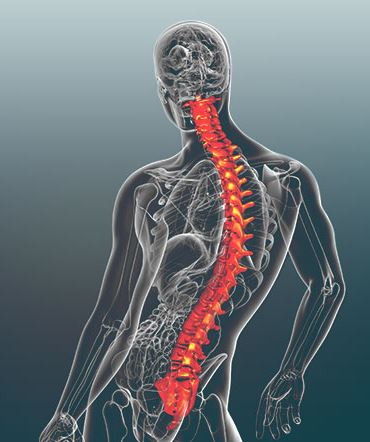
You may be a candidate for Minimally Invasive Lateral fusion
Scoliosis
Scoliosis is a common spinal condition affecting over 3 million people in the United States per year. In fact, approximately 2% – 3% of Americans aged 16 have it. Defined as a sideways curvature in the normally straight vertical path of the spine, scoliosis oftentimes surfaces during the rapid growth spurt just before puberty. Females tend to have a higher risk of developing this condition than males.
There are four primary types of scoliosis, including:
- Neuromuscular: Resulting from reduced muscle or nerve function, this form of scoliosis is usually seen in those with cerebral palsy, spina bifida, or other conditions that are accompanied by paralysis. Neuromuscular scoliosis is also commonly referred to as myopathic scoliosis.
- Degenerative: Degenerative scoliosis typically spurs from the thinning of the bones, caused by aging and general wear and tear. Unexpected injury or trauma can also cause this type of scoliosis. It is one of the few types of scoliosis that healthy patients may begin to experience in adulthood.
- Congenital: If a patient is born with a bone abnormality and they develop scoliosis as a result, their condition is considered congenital scoliosis. This ailment develops in the uterus and can be recognized during a child’s infancy. Congenital scoliosis is very rare, affecting only one in 10,000 children. However, those who suffer from this complication generally require corrective surgery.
- Idiopathic: This type of scoliosis arises from no known cause. However, strong evidence suggests that this type of scoliosis can be inherited and has a genetic component.
The severity of scoliosis depends upon the shape, location, and direction of the intrusive curve. Lateral arcs are generally described as “S-shaped” curves or “C-shaped” curves, as they resemble the deviations of these letters.
Other common terms used to indicate the details of a specific curvature include:
- Dextroscoliosis: The most frequently occurring type of spinal curve, dextroscoliosis develops when the spine bends toward the right. This usually happens in the thoracic (middle back) area of the spine and may be isolated (forming a “C-shape”) or be accompanied by another curve moving in the opposite direction in the lower spine (creating an “S-shape”).
- Levoscoliosis: A spinal curve to the left, levoscoliosis usually surfaces in the lumbar (lower back) region of the spine. However, when levoscoliosis does occur in the thoracic spine, it may indicate a spinal cord tumor. For this reason, it is important to diagnose levoscoliosis quickly.
- Thoracic Scoliosis: In the majority of cases, scoliosis occurs in the middle (thoracic) spine.
- Lumbar Scoliosis: Sometimes, scoliosis may occur in the lower (lumbar) spine.
- Thoracolumbar Scoliosis: Some patients may suffer from scoliosis that involves the vertebrae in both the lower thoracic spine and the upper lumbar spine. This condition is referred to as thoracolumbar scoliosis.
Causes
If you discover a spinal curvature, it is important to speak with a licensed spine professional to determine the root cause. Many factors can be easily managed, but others can be dangerous and require timely medical attention.
Common causes include:
- Congenital abnormality or possible genetic predisposition
- Cerebral palsy
- Muscular dystrophy
- Osteoporosis
- Aging
- Bone degeneration
- Sudden injury, trauma or accident
- Infection
- Tumor or growth
By analyzing the spinal curve and performing non-invasive tests when necessary, spine specialists can typically determine the underlying cause and then build a treatment plan best suited for each unique case.
Symptoms
Because scoliosis can occur gradually and may not be accompanied by any immediate pain, it can be difficult to spot. However, addressing it promptly can increase your chance of obtaining effective treatment and retaining your quality of life.
Look out for these symptoms:
- When viewed from the back, the spine appears curved
- One shoulder appears higher than the other
- One shoulder blade protrudes more than the other
- One hip appears higher or more prominent than the other
- The waist appears uneven
- Dull or sharp back pain is experienced
- Difficulty breathing (in extreme cases)
- One leg appears shorter than the other
- The body tilts to one side
Minimally Invasive Treatment Approach
Dr. T will review your symptoms, family history, and physical state to determine the severity of your condition. Based on this information, we will create a personalized treatment plan designed to fit your needs and goals.
Unless you are suffering from progressive or severe scoliosis (typically determined by the degree to which your spine curves), we generally provide conservative treatments, such as:
- Radio frequency ablation
- Back bracing
- Specialized exercise or physical therapy
- Spinal rehabilitation programs
Even if your scoliosis is minor and appears to be stationary, we will carefully observe your condition to ensure safety. If the curvature in the spine expands greater than 20 – 30 degrees and conservative treatments are ineffective, we may suggest the option of minimally invasive spine surgery. Generally, these surgeries use small amounts of bone graft or bone marrow aspirate to fuse the area of the curve and correct the spine.
MIS-Lateral Fusion in conjunction with MIS-Anterior Fusion and MIS-Posterior fixation are the minimally invasive techniques that Dr. T can offer his patients if you have exhausted non-surgical modalities and the symptoms impact your quality of life and functional activities.
When considering minimally invasive surgery, patients should note the many benefits these advanced techniques offer. Unlike traditional surgery, minimally invasive surgery involves:
- Small incisions
- Reduced blood loss and scarring
- Minimal trauma to surrounding muscle and tissue
- Quicker recovery times, allowing patients to return to work, school, and daily activities sooner
- Faster pain relief and eliminated discomfort
We look forward to helping you feel better, faster! CONTACT US
